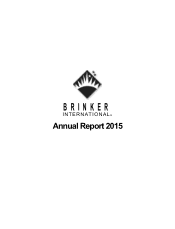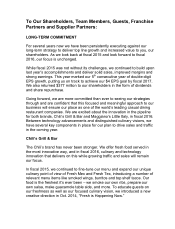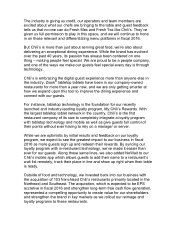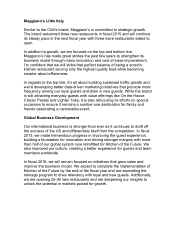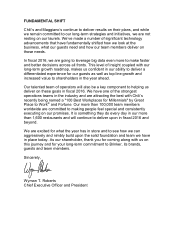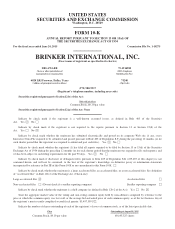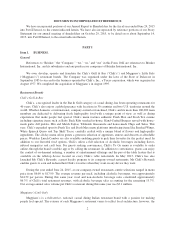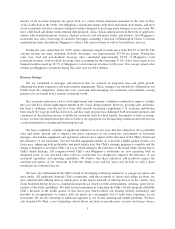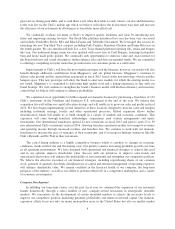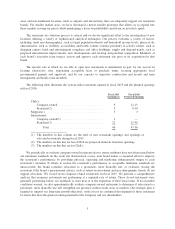Chili's 2015 Annual Report Download - page 11
Download and view the complete annual report
Please find page 11 of the 2015 Chili's annual report below. You can navigate through the pages in the report by either clicking on the pages listed below, or by using the keyword search tool below to find specific information within the annual report.
areas and non-traditional locations (such as airports and universities) that can adequately support our restaurant
brands. For smaller market areas, we have developed a newer smaller prototype that allows us to expand into
these markets serving our guests while maintaining a focus on profitability and return on invested capital.
The restaurant site selection process is critical and we devote significant effort to the investigation of new
locations utilizing a variety of sophisticated analytical techniques. Our process evaluates a variety of factors,
including: trade area demographics, such as target population density and household income levels, physical site
characteristics, such as visibility, accessibility and traffic volume; relative proximity to activity centers, such as
shopping centers, hotel and entertainment complexes and office buildings; supply and demand trends, such as
proposed infrastructure improvements, new developments and existing and potential competition. Members of
each brand’s executive team inspect, review and approve each restaurant site prior to its acquisition for that
brand.
The specific rate at which we are able to open new restaurants is determined, in part, by our success in
locating satisfactory sites, negotiating acceptable lease or purchase terms, securing appropriate local
governmental permits and approvals, and by our capacity to supervise construction and recruit and train
management and hourly team members.
The following table illustrates the system-wide restaurants opened in fiscal 2015 and the planned openings
in fiscal 2016:
Fiscal 2015
Openings(1)
Fiscal 2016
Projected Openings
Chili’s:
Company-owned ............................... 9 11-13
Franchise(2) .................................. 5 8-10
Maggiano’s ....................................... 3 3
International:
Company-owned(3) ............................ 1 —
Franchise(3) .................................. 22 25-30
Total .................................... 40 47-56
(1) The numbers in this column are the total of new restaurant openings and openings of
relocated restaurants during fiscal 2015.
(2) The numbers on this line for fiscal 2016 are projected domestic franchise openings.
(3) The numbers on this line are for Chili’s.
We periodically re-evaluate company-owned restaurant sites to ensure attributes have not deteriorated below
our minimum standards. In the event site deterioration occurs, each brand makes a concerted effort to improve
the restaurant’s performance by providing physical, operating and marketing enhancements unique to each
restaurant’s situation. If efforts to restore the restaurant’s performance to acceptable minimum standards are
unsuccessful, the brand considers relocation to a proximate, more desirable site, or evaluates closing the
restaurant if the brand’s measurement criteria, such as return on investment and area demographic trends, do not
support relocation. We closed seven company-owned restaurants in fiscal 2015. We perform a comprehensive
analysis that examines restaurants not performing at a required rate of return. These closed restaurants were
generally performing below our standards or were near or at the expiration of their lease terms. If local market
conditions warrant, we also opportunistically evaluate company-owned restaurants to determine if relocation to a
proximate, more desirable site will strengthen our presence in those trade areas or markets. Our strategic plan is
targeted to support our long-term growth objectives, with a focus on continued development of those restaurant
locations that have the greatest return potential for the Company and our shareholders.
5

